Dolomites Adventure Travel Guide & The 2026 Milano Cortina Olympics
Ready to explore Italy beyond the usual sights? Our Dolomites Adventure Travel Guide is your perfect trip companion! Whether you love to hike, ski, road cycle, or mountain bike, the Dolomites offer endless opportunities for exploration.
In addition, the excitement is building as the Dolomiti region will host some of the events for the 2026 Milano – Cortina Winter Olympics and Paralympics from February – March 2026. The Winter Olympics were last hosted in the area in 1956 in Cortina d’Ampezzo, and major improvements are underway to ensure Italy shines on the world stage!
This Dolomites Adventure Travel Guide will include:
- What Makes the Dolomites Special
- How to Get There
- 10 Best Dolomites Travel Adventures
- Where to Stay During Your Dolomites Travels
- Attending the 2026 Milano Cortina Winter Olympics
As adventure travelers, we love the Dolomites for their access to ski and climb towering peaks, ride bikes through rolling green meadows, visit cozy mountain huts, and swim in crystal clear lakes. Of course, it wouldn’t be Italy if the most delicious food wasn’t a part of the journey!
So let’s dive into why Dolomites adventure travel is so special, and along the way, we’ll provide you with lots of tips to help you plan your trip! Andiamo, let’s go!
What Makes the Dolomites Special?
Before we dive into the adventures, it’s important to know a little about the history of the Dolomites and why this region has a UNESCO World Heritage Site designation.
When you first arrive, you’ll notice a difference in the architecture, the food, the language, and the culture of the Dolomites compared to the rest of Italy. This is due to several factors:
- Rugged mountains provided geographic isolation from the rest of Italy
- Inhabitants were self-sufficient farmers who raised livestock and grew vegetables
- Harsh alpine climate, with elevations over 10,000ft.
- The region was part of the Austro-Hungarian Empire
- The Roman Empire brought Latin to the region, which evolved into Ladin, a language that is still spoken
- During WWII, the Dolomites region was under control of Nazi Germany
On top of the geographic isolation, the Dolomites were annexed from the Austro-Hungarian Empire to Italy during Italy’s unification in 1919. So the Dolomites region has only been a part of Italy for just over 100 years! In addition, during WWII, the Dolomites fell under the control of Nazi Germany and areas like the Brenner Pass were one of few roads to and from Germany. Therefore, this brought a strong German influence into the region that has remained intact til this day.
Regional Names and Languages Spoken in the Dolomites
The Dolomites area was called ‘Tyrol’ or ‘Tirol County’ by the Holy Roman Empire. Tyrol or South Tyrol is still used, and Tyrolean architecture and food dominate the region. In addition, the Ladin language and the farming culture have been preserved through the centuries.
When you visit, you will see signs in Italian, Ladin, and German. All three languages are spoken throughout the region. We’ll use both the Ladin and Italian names for places throughout this blog when possible.
In case you are wondering how the Dolomites got their name, it’s thanks to French geologist Déodat de Dolomieu, who first identified the rocky mineral ‘dolomite’ in the 18th century. Dolomite is similar to limestone, with a striking pale and jagged appearance. This creates a dramatic landscape when complemented by shimmering alpine lakes, quaint Tyrolean villages, and rolling alpine meadows dotted with cows and sheep.
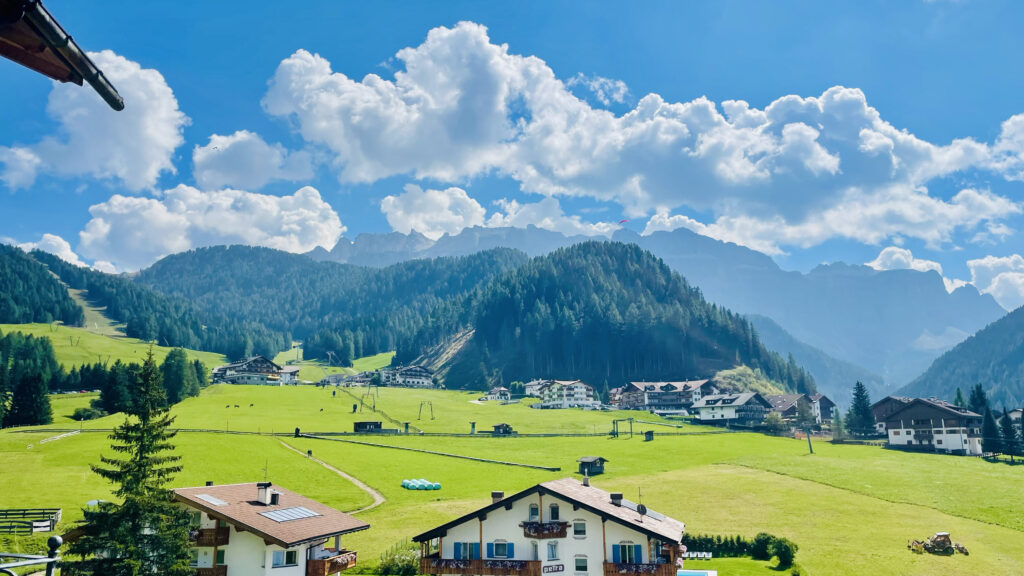
The mountain homes throughout the Dolomites look more like Austrian or Swiss chalets than Italian villas. Each house is often connected to a farm, with cows, sheep, and goats grazing in the meadows.
Dolomites Adventure Travel Tips: How to Get There
The Dolomites are part of the Alps and are located in northeastern Italy. Within a few hours, you can reach the borders of Austria, Switzerland, and Germany.
If you plan to fly to begin your Dolomites adventure travels, there are several international airports nearby:
- Venice Marco Polo Airport (VCE) – 2.5 hours
- Milan Malpensa (MXP)- 4-4.5 hours
- Innsbruck Airport (INN) – Located in Austria, 2 hrs
- Munich Airport (MUC)- Located in Germany, 3.5 hrs
In addition, there are also smaller airports like Verona (VRN), Treviso (TSF), and Bolzano (BZO), which are perfect if you’re coming from nearby EU countries or London and the UK. The closest airport to the Dolomites is in Bolzano, which is about 22 miles or 40 minutes away.
From all major airports, renting a car is the best way to get around. Public transportation can be limited in towns like Val Gardena, Canazei, Castelrotto, and Alta Badia. Even Cortina d’Ampezzo does not have a dedicated train line! This could prove challenging during the 2026 Milano-Cortina Olympics, as parking is very limited in Cortina. More tips on visiting the Dolomites during the Winter Olympics to come!
Speaking of trains, there is service into the Dolomites region from cities like Rome, Venice, and Milan. However, you’ll have to find buses, hire a tour guide, or rent a car to explore deep into the Dolomiti region. If you are interested in arriving by train, you’ll want to book tickets to one of the following stations:
- Bolzano/Bolzen, if coming from Rome, Milan, or other points south and west
- Bressanone, if you’re coming from the north in Switzerland or Austria
- Calalzo-Pieve di Cadore-Cortina– if arriving from Venice
If you’re looking for more scenic train travel, check out the Glacier Express, which goes from Zermatt to St. Moritz, or the Bernina Express. This beautiful scenic train ride crosses 196 bridges and 55 tunnels through the Swiss Alps from St. Moritz to Tirano, Italy!
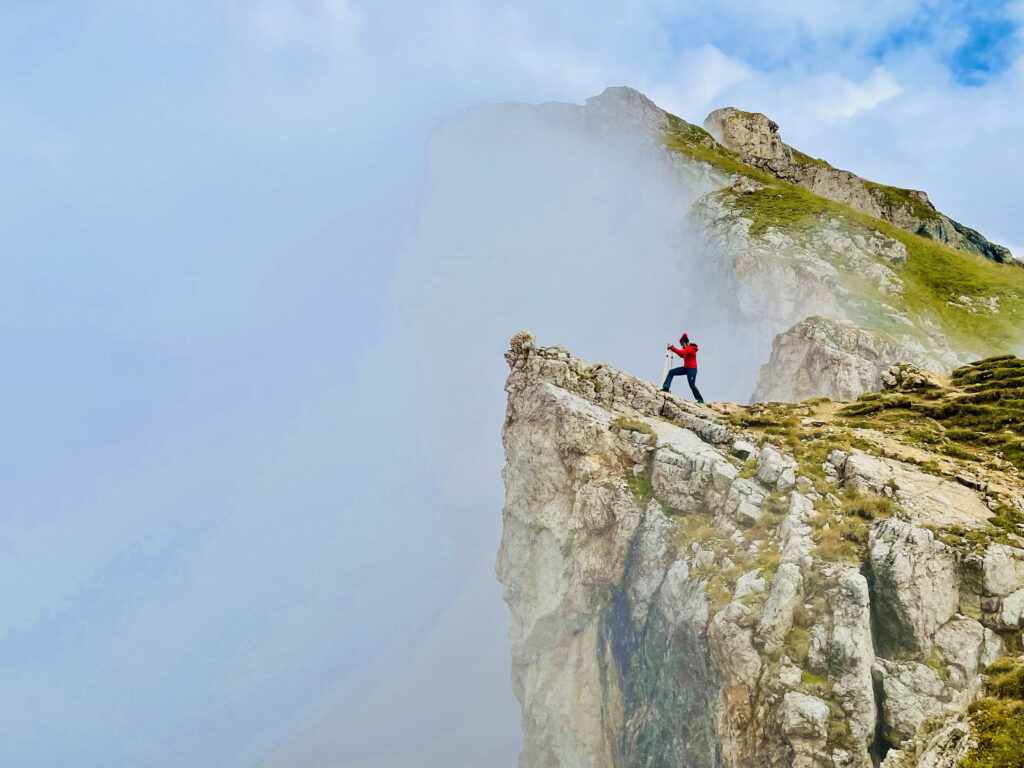
Hiking along the Seceda ridgeline is not for the faint of heart, but you’ll be rewarded with incredible views, even if the foggy mist rises up from the valley below!
Top 10 Things To Do On Your Dolomites Adventure Travels
When it comes to Dolomites adventure travel, there are so many activities to fill your days that you’ll find it hard to sit still. Below are our top 10 things to do in the Dolomites, and each time we visit, we discover something new!
1. Explore the Seceda Ridgeline
First up in our Dolomites adventure travel itinerary is to hike around the iconic peaks of the region, the best being Seceda above Ortisei. The easiest way to reach Seceda is via the Ortisei-Furnes-Seceda cable car, which departs from Ortisei in Val Gardena and takes you up to 2,500 meters in just minutes! Once at the top, you’ll find a stunning network of hiking trails, from easy panoramic walks to more challenging treks leading to the Puez-Odle Nature Park.
At the summit, Rifugios such as Baita Sofie Hütte and Baita Daniel Hütte await and offer cozy alpine hospitality, serve delicious South Tyrolean cuisine, and provide an excellent rest stop with breathtaking terrace views. Whether you visit in summer for hiking or winter for skiing, Seceda offers one of the most spectacular vistas in the entire Dolomites.
2. Go Rock Climbing at Cinque Torri
The Dolomites are a legendary climbing destination that attracts rock climbers from around the world. Here you’ll find thousands of routes ranging from beginner-friendly to multi-pitch climbs. Many climbs date back to the early 1900s, with famous climbers like Reinhold Messner, Emilio Comici, and other pioneers setting challenging routes.
The rock is dolomite or limestone in most areas, meaning big pockets, sharp edges, and lots of interesting features. One of the most popular areas for trad and sport climbing in the Dolomites is Cinque Torri. Cinque Torri is a stunning rock formation known for its towering spires that attract hikers, climbers, and history enthusiasts. In addition, this area is also famous for its WWI open-air ‘museum’, featuring restored trenches and military outposts from the war.
To get there, take the Cinque Torri chairlift from Bai de Dones, just a 20-minute drive from Cortina d’Ampezzo. Once you reach the top, you’ll arrive at Rifugio Scoiattoli. From here, it’s a few minutes walk on a gently sloping path with spectacular alpine scenery to reach Cinque Torri.
The trails around Cinque Torri offer breathtaking 360-degree views of the surrounding peaks, including Tofane and the Lagazuoi Massif. Whether you’re hiking, climbing, or simply enjoying the views, Cinque Torri is a must-visit in the Dolomites! Other great climbing areas include:
- Marmolada
- Tre Cime di Lavaredo
- Sella Group- Piz Ciavazes
If you want to try rock climbing in the Dolomites and are new to the sport, hire a guide. Most towns offer guiding services, like Val Gardena Mountain Guides, Alta Badia Guides, or Guide Alpine Cortina. Going with a guide means they’ll take care of the gear, ensure the route selection is within your abilities, and you won’t get lost!
3. Ski or Snowboard the Sella Ronda
One of the most famous circuits in the Dolomites, the Sella Ronda, takes you on a breathtaking ski loop around the Sella Massif. The Sella Ronda route connects four major ski resort towns: Val Gardena, Alta Badia, Arabba, and Val di Fassa. You can ride the Sella Ronda clockwise (orange route) or counter-clockwise (green route), and there is signage at each resort to help you find your way.
You will need a Dolomiti Superski pass, and be prepared for a long day. However, the Sella Ronda passes mountain refugios at the top of the climbs and the villages in the valleys, so you’ll always have a place to stop, rest, and refuel.
With over 1,200 kilometers of ski slopes and 450 lifts, Dolomiti Superski is one of the largest ski areas in the world and includes many other resorts than just the four mentioned above. Cortina d’Ampezzo is on the Dolomiti Superski. Whether you’re carving down perfectly groomed runs or exploring off-piste terrain, this interconnected network of resorts offers something for every level of skier.
Skiing the Sella Ronda would be a great activity if you’re traveling to the Dolomites for the 2026 Milano-Cortina Winter Olympics and Paralympics! The Olympic ski and snowboarding events will not be held at any of the resorts on the Sella route, so it will remain open to skiers all winter long.
Distance: 25 miles/ 40 km
Elevation Gain/Loss: 7,800ft (2,400m) descent, you’ll get uphill by ski lift/cable car
Time Required: 4–6 hours (without long breaks)
Difficulty: Intermediate (some red runs, no black runs required)
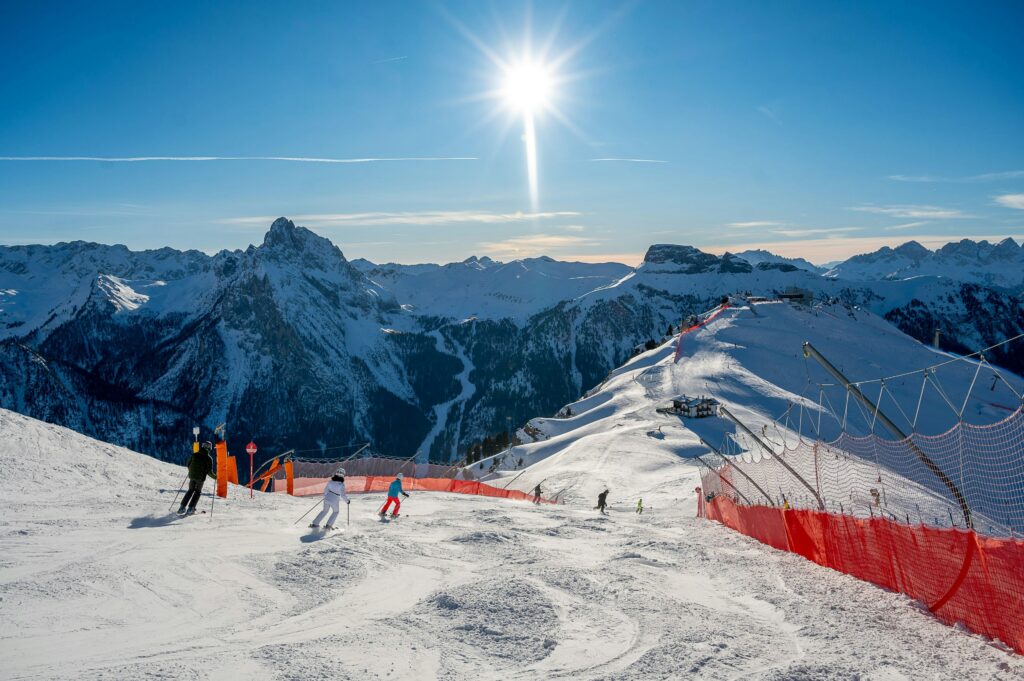
The Dolomite Superski gives you access to over 12 ski resorts, 16 ski areas, and over 450 lifts!
4. Explore by Bicycle on Your Dolomites Adventure Travels
Cycling in the Dolomites is filled with exhilarating climbs and descents that take your breath away. There are plenty of bike shops throughout the Dolomites where you can rent a road bike, helmet, and pick up any other gear you might have left at home.
You can also ride the Sella Ronda by bike and loop around the roads that connect each valley of the Sella Group- Val Gardena, Alta Badia, Arabba, and Val di Fassa. If you choose to do the Sella Ronda bike route, here are the details for the road bike route only (more on the Sella Ronda mountain bike route below!):
Distance: 36 miles/ 58km- start in any of the 4 valleys/resorts
Elevation Gain/Loss: 5,900ft ascending (1,800m), 5,900ft descending (1,800m)
Time Required: 4–6 hours (depending on fitness level)
Difficulty: Challenging (steep climbs/descents, high altitude, winding roads)
Besides cycling the Sella Ronda, which you can ride almost all year round (when the roads are clear of snow), don’t miss the times when they are also free from car traffic! These include the Maratona dles Dolomites, a famous cycling event in July, and the Sella Ronda Bike Day is a car-free day for cyclists held twice a year, in June and September.
5. Visit Lago di Braies
No Dolomites trip is complete without visiting its picturesque alpine lakes, and Lago di Braies or Pragser Wildsee, also known as the “Pearl of the Dolomites,” is a must-see. With its stunning emerald waters reflecting the wild mountain peaks, Lago di Braies is worth the trip north from Cortina d’Ampezzo. Rent a boat and go for a paddle, or hike the easy 2-mile loop around the lake. In addition, the lake temperature gets up to 68 degrees in the summer, so it also makes for a refreshing dip!
Other beautiful alpine lakes to add to your Dolomites adventure travel itinerary include:
- Lago di Sorapis
- Lago di Misurina
- Lago di Carezza
- Lago di Anterselva
6. Try a Via Ferrata
The Dolomites are home to an extensive network of via ferratas, and this is one of our favorite things to do during our Dolomites adventure travels! A via ferrata (Italian for “iron path”) is a climbing route equipped with steel cables, ladders, and iron rungs. While you ascend rocks the way a rock climber would, via ferratas differ in that they have protection already in place. You will, however, need to wear a climbing harness and use a special lanyard system, like the Petzl Scorpio, when climbing a via ferrata.
Via ferratas were originally built during World War I in the Dolomites to help soldiers move through the mountains. Along the routes, you’ll find old war bunkers, trenches, tunnels, and signage about the battles fought. Today, more routes have been added to offer an exciting mix of climbing and hiking, making alpine peaks accessible to adventurous travelers.
If you’ve never done a via ferrata before and you are not a climber, go with a guide. They can provide gear and navigation, and you will learn the techniques of climbing a via ferrata. Here’s our favorite Dolomiti via ferratas to include in your adventure travel plans:
Via Ferrata Tridentina- Sella Group
The Via Ferrata Tridentina is a classic, offering spectacular views from the Refugio Pisciadù and a suspension bridge.
Location: Alta Badia, Sella Group
Time: 3-4 hours
Effort: Moderate
Via Ferrata Ivano Dibona- Monte Cristallo
The Via Ferrata Ivano Dibona is a gorgeous route with a suspension bridge, plus lots of WWI artifacts.
Location: Near Cortina d’Ampezzo
Time: 5-7 hours
Effort: Moderate
Via Ferrata delle Bochette Alte- Brenta Dolomites
The Via Ferrata delle Bochette offers one of the most scenic and historic routes, it’s a true alpine traverse with exposed ledges and best done as a hut-to-hut trek!
Location: Near Trento in the Brenta Dolomites
Time: 6-8 hours
Effort: Challenging
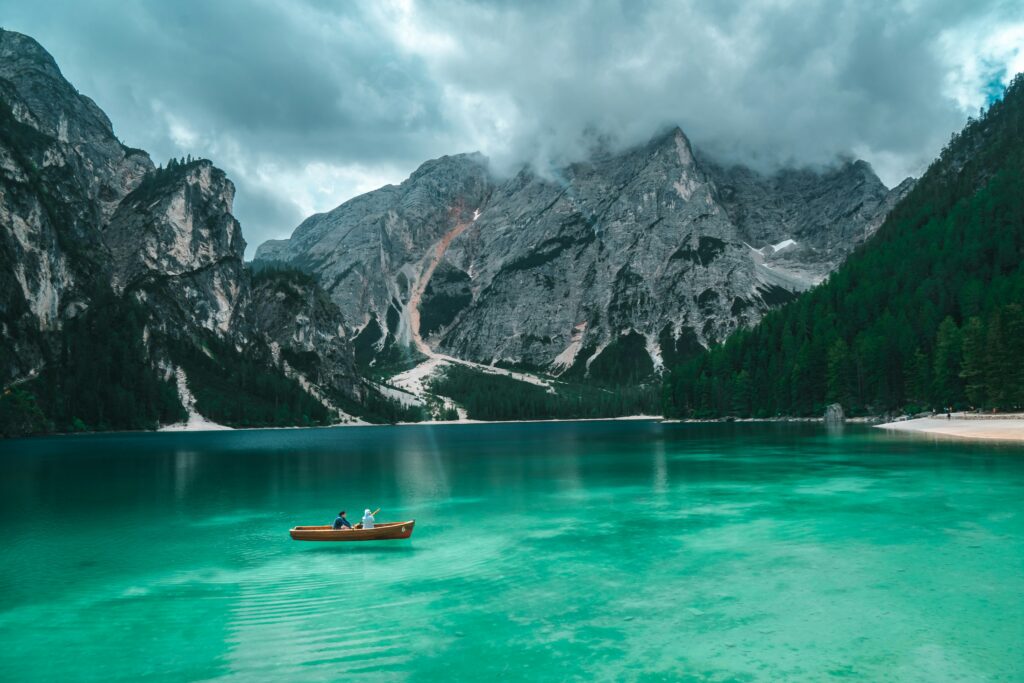
One of the most photographed lakes of the Dolomites, Lago di Braies, should be on every traveler’s list! In the winter, it’s covered in snow, but in the summer, you can rent a boat and paddle around the lake.
7. Go Mountain Biking: The Sella Ronda MTB
Riding the Sella Ronda by mountain bike was one of our favorite adventures of our Dolomites travels! We rented bikes and helmets at Intersport in Val Gardena, however, there are several bike shops in each town along the route. Make sure to pick up a Sella Ronda MTB map at the bike shop and buy a Dolomiti Supersummer Pass. Plan your day, leave extra time for stops, and avoid getting stuck when the lifts close for the day.
If you want to make it harder, you can ride uphill instead of taking a lift, but we recommend taking the ski lifts or cable cars. Then you can truly enjoy the sweeping descents as you plummet thousands of feet into the valleys below!
Distance: 36 miles/58km
Elevation Gain/Loss: 1,500ft (450m) gained (mostly you’ll take lifts), 13,629ft descending!!
Time Required: 6-8 hours
Difficulty: Moderate to Difficult
Besides cycling the Sella Ronda, there are lots of flow trails and groomed bike parks in the Dolomites. Many ski lifts and gondolas will accommodate mountain bikes, so you can take the lifts up and enjoy lapping the big descents all day!
8. Hike the Tre Cime Lavaredo Loop
The Tre Cime di Lavaredo Loop is one of the most iconic hikes in the Dolomites, with breathtaking views of the famous three towering peaks. This moderate 6.2-mile (10km) loop takes about 3-4 hours to complete and starts from Rifugio Auronzo, which is accessible by car or shuttle bus from Cortina d’Ampezzo.
The well-marked trail winds past Rifugio Lavaredo and climbs to Forcella Lavaredo, where you’ll get stunning close-up views of the Tre Cime’s north faces. Continuing around the loop, you’ll pass Rifugio Locatelli, an excellent stop for a meal with panoramic vistas. This hike is best done in summer and early fall when the trails are clear of snow and the alpine scenery is most spectacular.
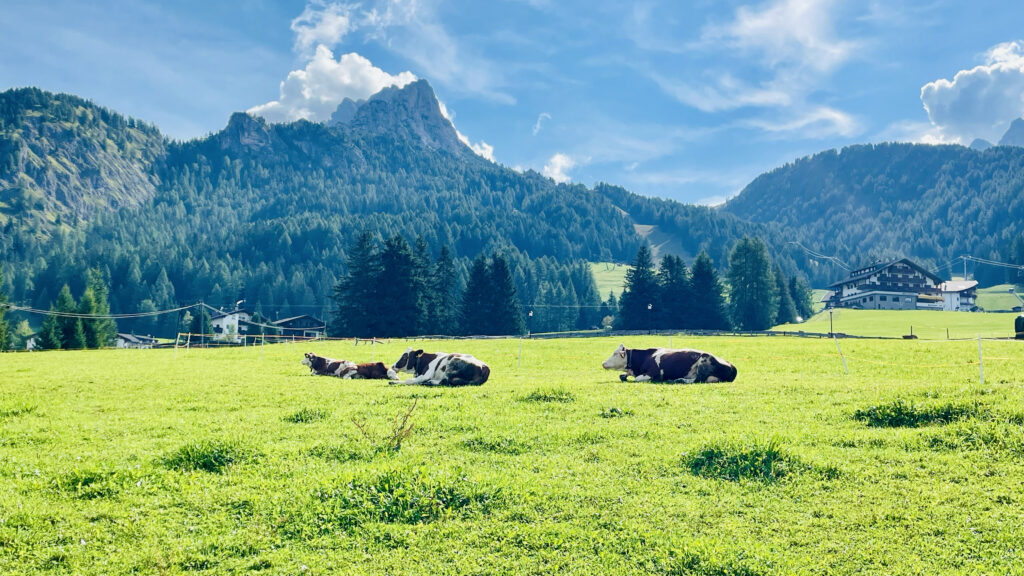
There are so many things to do in the Dolomites, but sometimes just sitting and watching the cows in Alpe d’Suisi is enough for me! Stay at least a few nights at an Agriturismo to learn about the farming culture practiced for centuries.
9. Visit Alpe di Suisi/Seiser Alm
Visiting Alpe di Siusi (Seiser Alm), Europe’s largest high alpine meadow, is a must for nature lovers and outdoor enthusiasts. This vast plateau offers breathtaking views of the Sassolungo and Sciliar peaks, and lush green pastures dotted with traditional wooden huts.
You can reach Alpe di Siusi by cable car from Ortisei (St. Ulrich) or Castelrotto (Kastelruth). Private cars are restricted in Alpe di Siusi during peak hours unless you’re a resident, to help preserve this pristine landscape.
In summer, Alpe di Siusi is a paradise for hiking, mountain biking, and horseback riding, while in winter, it transforms into a cross-country skiing and snowshoeing wonderland. The area is home to charming rifugios where you can enjoy local South Tyrolean specialties like speck, dumplings, and apple strudel while soaking in the stunning alpine scenery.
10. Take the Cable Car to Sassolungo/Langkofel
Taking the cable car up to Sassolungo (Langkofel) is an incredible way to experience the heart of the Dolomites, and I think we saved the best for last. The Forcella Sassolungo lift, a unique two-person standing cable car, departs from Passo Sella and ascends to Forcella del Sassolungo at 8,796ft (2,681m). The ride itself is an adventure, just getting into the cable car is an adventure!!
At the top, you can explore Rifugio Toni Demetz, a cozy mountain hut with spectacular panoramas and delicious local food. From here, hikers can descend into the Sassolungo Group or continue to the Friedrich August trail for a stunning trek along the ridgeline.
There’s also great rock climbing at Sassolungo. Whether you’re a hiker, climber, or simply want to enjoy the views, the Sassolungo cable car is a must-do in the Dolomites!

From Val Gardena, take the tiny cable car up to the top of the Sassolungo and enjoy the views from the Rifugio Toni Demetz!
Where to Stay During Your Dolomites Travels
The villages of the Dolomites are a mix of traditional alpine mountain towns, charming ski resorts, and small rural settlements that blend Italian, Austrian, and Ladin cultures. Many have a Tyrolean feel, with wooden chalets, frescoed churches, and pedestrian walkways closed to car traffic.
If you are planning your Dolomite adventure travel itinerary around the 2026 Winter Olympics, pick a town close to where the Olympic events will be held to avoid long drives to and from the venue.
In addition, if you’re buying a Dolomiti Superski or Supersummer Pass, ensure the towns you’re visiting are on the pass. There are so many Dolomiti villages and 12 ski resorts to choose from! Here are the best Dolomites towns to use as a base for exploring the area:
1. Cortina d’Ampezzo:
A premier luxury resort town close to Cinque Torre, Tre Cime di Lavaredo, Lago Misurina, and Lago di Braies. The 2026 Winter Olympics will feature several events in town and on the slopes!
2. Ortisei/St. Ulrich (Val Gardena):
A bustling town close to Bolzano (the closest major city to the Dolomites) and with access to Alpe di Suisi, Castelrotto, and the famous Seceda ridgeline.
3. Selva/Wolkenstein or Santa Cristina (Val Gardena):
Val Gardena’s quieter, more central locations for skiing and mountain biking are Selva/Wolkenstein and Santa Cristina. This is where we’ll be living!
4. Madonna di Campiglio:
A stylish resort town in the southern Dolomites with a lively atmosphere and close to Lago di Garda, Acro (great climbing area), and Trento.
5. Canazei (Val di Fassa):
A charming ski town with access to the Sella Ronda, and close to Cinque Torre. Canazei is also close to a few of the Milano-Cortina Winter Olympics venues in Predazzo!
Mountain Rifugios & Agriturismos
In addition to the Dolomites villages we’ve highlighted, we highly recommend booking a night or two at a mountain refugio (or rifugio). The refugios are often accessible by ski lift, cable car, or by hiking up from the valley. Most refugios will offer meals, accommodations, and a well-stocked bar. They’ll also have nice open spaces both inside and outside to relax. There is no central booking system for the Dolomites refugios. Your best bet is to find a refugio close to the town you want to explore, then look up their website for more information on booking a night.
We stayed at the Rifugio Scoiattoli at Cinque Torri, which was the highlight of our trip! It also allowed us more time to hike and climb in the Cinque Torri area. We spent evenings there watching the sunset, enjoying an Aperol spritz while the last hikers departed downhill and the goats and sheep slowly made their way up. It was like a fairy tale.
In addition to staying at a mountain rifugio, experience traditional Ladin and farming culture by spending a night at an Agriturismo (Agriturismi). We spent a week at the Larciunëi de Sot in Selva Val Gardena and had the chance to meet all the animals, plus we had fresh eggs, milk, and bread delivered to our apartment daily!
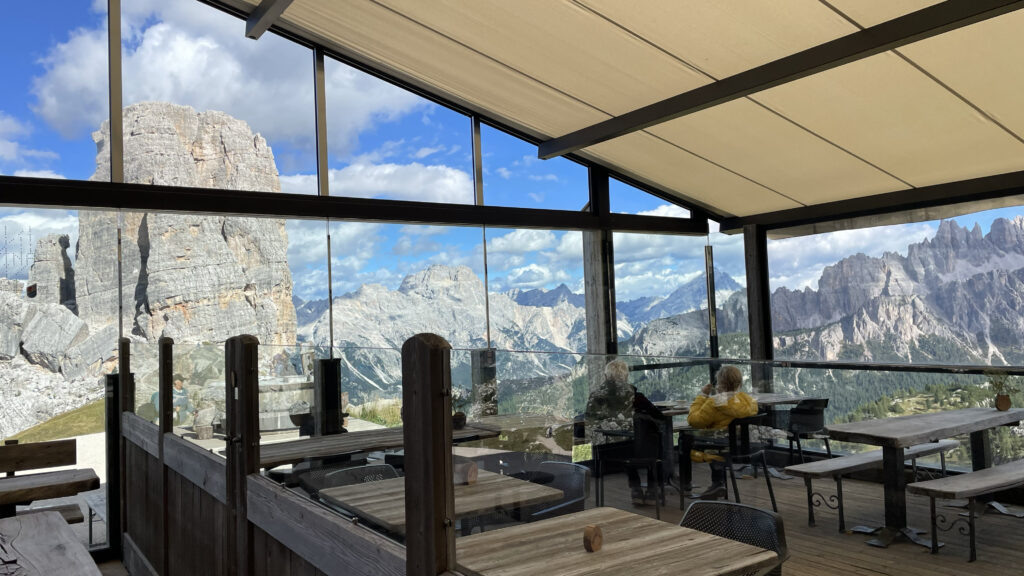
The views from Rifugio Scoiattoli at Cinque Torri are simply unbelievable! Whether summer or wintertime, staying at a refugio is one of the best ways to experience the Dolomites!
Attending the 2026 Milano-Cortina Winter Olympics
Visiting the Dolomites during the 2026 Winter Olympics in Milano-Cortina will be an unforgettable experience, but planning ahead is essential. Expect high demand for accommodations, especially in Cortina d’Ampezzo, which will host key events like Alpine Skiing, Bobsled, Luge, Curling, and both Para Skiing and Para Snowboarding. If you want to avoid crowds, consider staying in Val Gardena, Alta Badia, or Val di Fassa, which offer incredible skiing but will mean a bit of a drive to the Olympic venues.
Two hours west of Cortina, you’ll find even more Olympic events: Ski Jumping, Nordic Combined, and Cross-Country Skiing near Predazzo in Val di Fiemme. North of Cortina, the biathlon will take place in Antholz/Anterselva.
Book guided tours, hotels, and car rentals well in advance, as prices will rise, and all areas will be busier than usual. Finally, embrace the festive atmosphere—whether you’re watching events live or exploring world-class skiing, the Dolomites will be buzzing with Olympic energy!
Final Thoughts on Planning a Dolomites Adventure Travel Itinerary
The Dolomites are a UNESCO World Heritage Site and one of the most stunning mountain ranges in the world. From dramatic peaks, pristine alpine lakes, and world-class outdoor activities, the Dolomites are a dream destination for adventure travelers.
With majestic views just outside your doorstep and trails suitable for all levels, all family members can enjoy the outdoors in the Dolomites. In addition, many high alpine trails can be easily accessed from towns throughout the Dolomites thanks to an abundance of ski lifts, gondolas, funiculars, and cable cars. Keep in mind, gondolas and ski lifts close at the end of the ski season (late March- early April), and then re-open in May/June through late October/early November for summertime activities.
Even if you’re not up for a big hike, taking a cable car up to one of the many mountain-top refugios can be quite exhilarating and an adventure in itself.
We hope this travel guide inspires you to visit. The Dolomites offer endless opportunities for exploration, plus a chance to step back in time and experience both Ladin cultural traditions and WWI history. If you do visit, please let us know when you’re coming so we can show you around! If you want more tips on travel in the EU, here are some of our more popular blogs:
- Exploring Spain’s Costa Brava: The Wild Coast
- Digital Nomad Visa: The Truth Behind What it Takes to Work Remotely in Europe
- Watching the Tour de France Live and In Person
Until next time, happy travels, and thanks for reading!
Meredith Caccese McConvill, Top Rope Media
Recent Comments